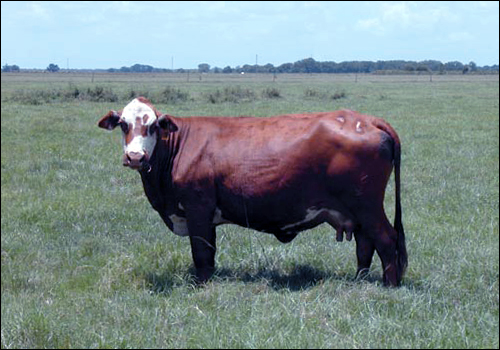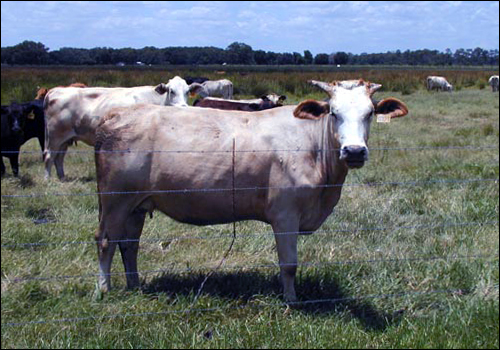- Return to Article Of The Month index
The Cost of Big Cows
March 2003
Dr. John Arthington - Range Cattle Research & Education Center, Associate Professor of Animal Sciences
The importance of cow efficiency has been largely overlooked by the cow-calf industry. Although our production systems have made important advances in the production of large calves with heavy weaning weights, the cost for maintaining the associated cowherd is often ignored. Cow efficiency is something that we all understand, but often do not consider in our day-to-day management decisions.

When discussing cow traits we routinely use terms like "easy-fleshing" and "easy-keeping". These characteristics are related to cow efficiency. In Florida, pasture forage availability is limited during the early spring at a time when most of our cows are in mid-lactation. This is an excellent opportunity to see cow efficiency at work on your operation. Within the herd we can identify that group of cows that are able to maintain body condition beyond the herd average even during harsh grazing conditions. Although these cows are maintaining moderate condition, their calves are usually as large as the herd's average. These cows have improved efficiency. Considering that over 60% of the annual costs for producing a calf are attributed to nutrition, our ability to identify efficiency traits and incorporate them into the cowherd is critical.

An average body size for mature Florida cows might run between 1000 and 1200 lb. It would be common to find these cows in commercial production systems across the state. Have you ever considered the costs associated with maintaining this difference in body size? On average, a mature cow will consume about 2.25% of her body weight in dry matter daily throughout the year. A typical diet must average about 50% TDN (dry matter basis) annually to maintain a mature cow. Using these figures, the 1200 lb cow will require about 820 lb of additional TDN per year compared to the 1000 lb cow. This added requirement will be most pronounced during the early spring when supplemental nutrition is critical to account for shortages in pasture forage. An average cost for supplemental TDN is about $0.08 per pound; therefore, the 1200 lb cow may require an additional $65 in supplemental feed compared to the 1000 lb cow. Using a weaned calf price of $0.90 per pound, the 1200 lb cow will need to wean a calf that is 72 lb heavier (on-average) than the 1000 lb cow just to offset her additional supplement costs. Usually, there are only minor differences in calf weaning weight between cows of similar breed that differ in size by only 200 lb.
The example above assumes a constant efficiency between both cow types. Our ability to identify cow efficiency traits and perpetuate them in the herd will likely be the new frontier for improving beef cow-calf profitability and sustainability.
For more information on understanding cow efficiency and how it relates to calf weaning weight, view "Cow Math - Using Weaning Weight to Estimate Cowherd Productivity".

